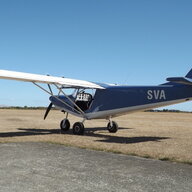After that, I think smooth running comes down to carb synchronisation.
That starts with the standard Rotax adjustment of the idle throttle stops and idle jets, which is a quick and simple job.
I took particular care installing my throttle linkages and routing the cables, then adjusted the cables so that both carbs come off the full throttle stop at the same time when when throttling back. Since much of flying is done at higher engine speeds, this seemed to me to be the most important end of the range. I do check at the other end of the range...that both carbs come off the idle throttle stops simultaneously, and in my case they do that too.
I made minor adjustments to maintain the synchronisation over the first 50hrs. Since then I have checked periodically but no further adjustment has been necessary.
I also fitted a simple idle position stop to the throttle bar that runs across the firewall: without this, if the pilot pulls back hard on the throttle, the load goes onto the carb throttle arms, and once they hit the carb idle stops, the arms will flex or distort.





